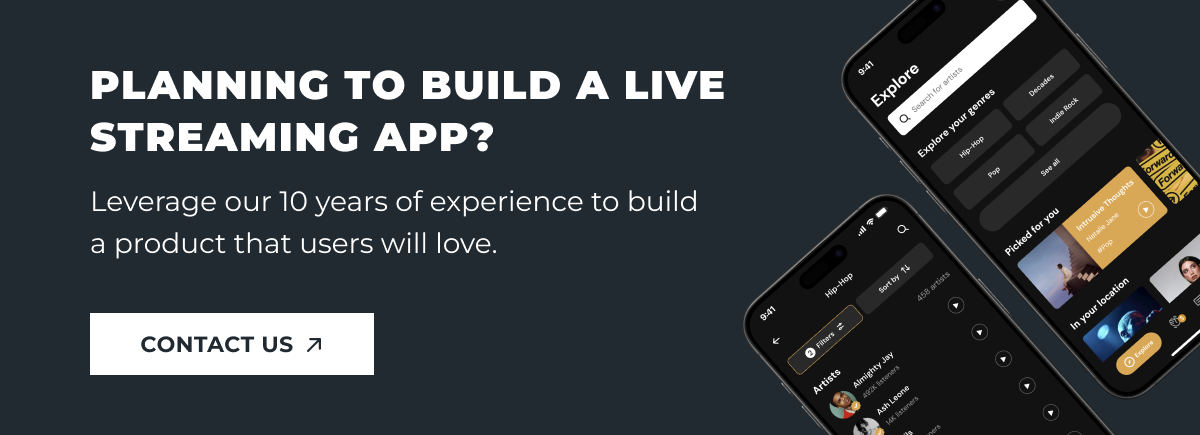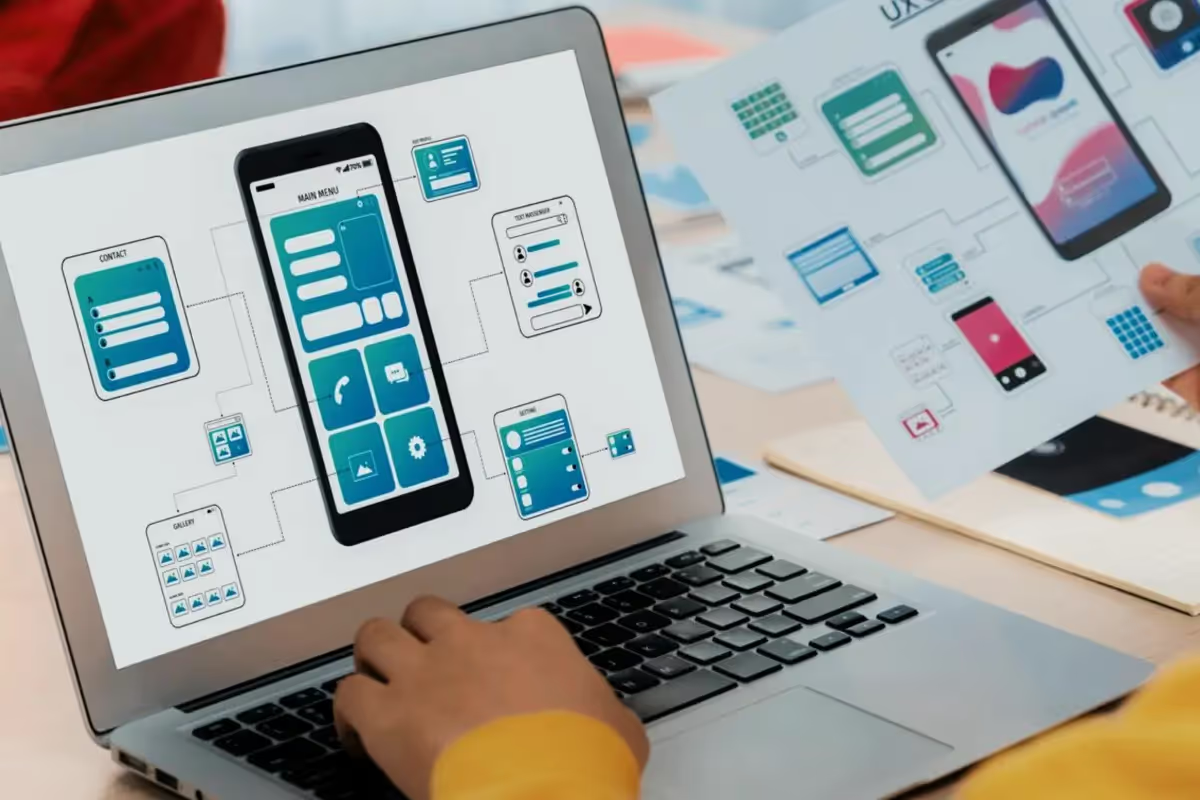Considering that the live streaming market is expected to reach $600.12 billion by 2032, it is predictable that many business strategists will want to try their hand in this profitable industry. The live streaming market faces a surprisingly fast growth, which could be explained by a high demand from the audience — people’s preferences shift toward real-time, interactive digital experiences.
However, strong consumer interest doesn’t cancel out their expectations: high product quality remains a must. Building a complex, five-star live streaming app is a challenging task that requires a lot of planning.
Many decisions must be made along the way, such as choosing the most viable platform for streaming content or assessing which features will deliver the highest engagement. To make the right choice, you’ll need a solid knowledge of the subject matter.
That’s where I can help you. My name is Aliona Nikolaeva, and I’ve been working as a product manager at Uptech for over 6 years. I make sure Uptech projects run smoothly — on time, on budget, and with great results.
In this article, I’ll share my professional insights on how to create a streaming app in 6 steps and guide you through the whole process.
Let’s get started!

What is a Live Streaming App?
First, let’s explore what a live video streaming app generally is.
As the name implies, live streaming apps are platforms that allow users to record and broadcast video simultaneously. Their fast expansion over the past few years comes down to several factors: faster internet speeds, better mobile cameras, easy-to-use tools, and the rise of the creator economy that rewards engagement and authenticity.
Live video streaming apps have fueled influencer marketing, entertainment, business marketing, and the way people interact over the internet. In short, live streaming has become one of the most direct and immersive ways to share experiences, tell stories, and build communities on the internet.
Here are some live streaming apps that are highly popular among users:
- TikTok
- Facebook Live
- YouTube Live
- Twitch
- Instagram Live
- Periscope
- Kuaishou
- Douyu
- Bilibili
- 17

Twitch, YouTube Live, and TikTok are the most popular live streaming apps out there, yet each has a different target audience focus.
Twitch is mainly used by gamers, esports fans, and creative streamers. It’s the platform that offers an interactive space built around communities and live chat.
YouTube Live, on the other hand, appeals to a broader audience — from educators and brands hosting webinars to creators streaming concerts, tutorials, or events.
TikTok Live, meanwhile, focuses on short-form, personality-driven streams where influencers, brands, and entertainers engage viewers through spontaneous content.
Facebook Live and Instagram Live are no strangers among social media users. These platforms are especially common among influencers, small business owners, and community leaders who use live sessions for product showcases, Q&As, tutorials, or behind-the-scenes content.
Meanwhile, Douyu is the Chinese alternative version of Twitch, which boasts a higher number of active users.
Interesting live streaming market statistics
Words are great, but when it comes to business strategic vision, numbers are far more effective. Here are some interesting statistics that show the impact video live streaming has within the digital space:
- In Q3 2025, across major platforms, people watched 29.45 billion hours of live streaming content.
- Live videos receive ~3× more engagement than regular uploaded videos.
- 89% of marketers use video, and 95% see video as a crucial tool in their strategy.
- 45% viewers say they’re willing to pay to watch their favorite streamers.
- 80% of people prefer live video over blog articles.
- Approximately 34% of Generation Z have shown interest in live streams, especially on social platforms.
- Companies that use video features grow revenue 49% faster than non-video users.
As you can see, video streams are getting a lot of attention from online users, making video streaming apps a high-impact business tool. For brands, creators, and companies alike, live video offers unmatched opportunities to build trust, increase engagement, and strengthen long-term customer relationships.
3 Types of Live Streaming Apps
Moving past definitions and statistics, there’s another critical point to cover — the types of live streaming apps. Before starting to develop a live streaming app, you need to determine which category your product fits into.
Below, I’ll describe 3 common types of live streaming apps.
Live broadcasting apps
Live broadcasting apps are arguably the most popular type of live-streaming apps. They allow users to broadcast live videos and sound to those who have access to the stream.
These platforms have given rise to a new generation of digital creators and influencers who build entire careers through live engagement.
Examples: Twitch, YouTube Live, Livestream.
Audio streaming
Take a video out of the picture, and you’ll have an audio streaming app. With an audio streaming app, you get to listen to audio that is transmitted over the internet in real time.
Audio streaming apps reshaped how people consume music, podcasts, and radio, offering instant access to millions of tracks anytime, anywhere. They offer AI-powered recommendations, curated playlists, and social discovery features that personalize the listening experience.
Examples: Spotify, YouTube Music, and Apple Music.
Video-on-demand streaming
This type of live streaming app allows users to schedule and watch their favorite TV shows online as and when they wish.
Unlike live broadcasts, VoD platforms store video content on servers and deliver it instantly when requested, giving users full control over what to watch and when.
Video-on-demand streaming apps have shifted audiences from cable TV to personalized, subscription-based platforms.
Examples: Common VoD apps are Hulu, YouTube TV, and Amazon Prime Video.
How to Create a Live Streaming App in 6 Steps: Guide for Startup Owners
Now, when you have a strong understanding of live streaming apps, we can move on to the video streaming app development process.
Check out the 6 key steps on how to create a live streaming app.

Step 1. Define your audience and their needs
You don’t want to create a live streaming app that is based on assumptions. Instead, you’ll want to learn and define the actual needs of users who will be using the app.
First of all, you need to understand who your audience is and why they would use your app. Too many products fail not because of poor technology, but because they solve the wrong problem or target the wrong users.
Start with uncovering product–market fit: a clear alignment between what your app offers and what users genuinely want. Instead of relying on assumptions, invest time in market and competitor research:
- Identify existing players (like Twitch, TikTok Live), study what they do well and where they fall short. Conduct SWOT and PESTLE analysis.
- Look for underserved niches or specific communities (for example, fitness trainers, educators, small business owners) where live interaction adds measurable value.
- Analyze market trends: for instance, the rising interest in live commerce, virtual events, or niche community streaming. These signals help you predict where demand is heading, not where it’s been.
During target audience research, think beyond demographics and focus on the problems your app will solve for the user. For example:
- Creators want a place to monetize and grow an audience.
- Viewers want authentic, interactive entertainment that feels personal.
- Brands want measurable engagement and customer connection.
Mapping these jobs-to-be-done will help you design core features and prioritize steps in development.
More than that, talk directly to potential users if you have an opportunity to do so. Conduct interviews, focus groups, and prototype testing to identify their real frustrations and must-have features early on. Even a simple clickable prototype can reveal whether your concept resonates and what it lacks.
Early validation helps you build your first beta community. These early supporters often become your most vocal advocates and testers.
Your live streaming app should have a reason to exist. Defining your audience and their real needs is how you move from a cool idea to a real, usable product.
Step 2. Choose monetization strategies
Ultimately, you’ll want to monetize the live streaming app, and here are the 3 most popular ways to do so.
- Paid app — charge the users a fee for downloading the app.
- Freemium — offer the app for free, but with some features accessible to paying users.
- Advertisements — run ads on the app to generate advertising fees.
Before deciding on pricing, study your target segment’s willingness to pay and how competitors capture value.
- Creator-centric apps (like Twitch) succeed with revenue-sharing, tips, and subscriptions.
- Entertainment and lifestyle apps (like TikTok Live) thrive on advertising and in-app purchases.
- Enterprise or event-based tools (like Vimeo Livestream) rely on paid plans or SaaS licensing.
Validating these assumptions early through surveys, interviews, or MVP paywall tests helps avoid misalignment between pricing and user expectations.
However, it’s a rare case when a product uses only one monetization model. Usually, it’s a mix of two or three because it’s more stable and safe. In our dedicated article, you can learn more about these monetization strategies and how free apps make money.
For example, Twitch, one of the most popular live streaming applications, makes money in at least 3 ways: subscription, advertising, and a cut of the payments for Bits — a virtual currency viewers buy to support streamers.
TikTok, by contrast, is a mass-scale ecosystem combining advertising, in-app purchases, and e-commerce integrations. Ads remain its primary driver, accounting for roughly three-quarters of total revenue, and include formats like in-feed videos, branded takeovers, and sponsored hashtag challenges. Beyond that, TikTok profits from digital gifts purchased during live streams and from its rapidly growing TikTok Shop, which takes a commission on every sale.
Another example is Vimeo, which operates as a SaaS video platform offering live streaming through paid plans for professionals and businesses that need reliable, high-quality broadcasting. These plans include features like multi-platform streaming, analytics, branded event hosting, and team collaboration tools.
Through Vimeo OTT, the platform also supports pay-per-view and subscription-based monetization, while enterprise clients can access advanced options such as audience control, CRM integrations, and service-level agreements. Since Vimeo earns from subscriptions rather than ads, its model focuses on predictable recurring revenue and long-term client retention.
Across all these examples, the common strategic insight is clear: live streaming profitability comes from diversification. The goal is to design monetization around long-term ecosystem health rather than short-term gains.
Step 3. Use a reliable hosting platform for live streaming and storage
You’ll then need to decide which platform is most viable for streaming, hosting, and storing the content. Choosing the cheapest provider is rarely a wise choice.
It’s tempting to go with the cheapest provider at the start, but live streaming is highly resource-intensive. Poor latency, buffering, or low-resolution playback can instantly drive users away and damage your reputation before you even scale. That’s why early technical decisions should align with your long-term growth plan, not just your initial budget.
While searching for a suitable option, focus on:
- Scalability. Choose a cloud provider that can easily handle traffic spikes during viral streams or major events.
- Global coverage. Look for providers with a wide content delivery network (CDN) to deliver streams quickly to users worldwide.
- Data security and compliance. If you’ll be handling user data, chat logs, or payment information, ensure your provider meets standards like GDPR, SOC 2, or ISO 27001.
For hosting and storage, you can go with options like Google Cloud Platform (GCP) or Microsoft Azure, which offer scalable and secure cloud services. For live streaming, you might look into specialized services such as StreamShark or Vimeo Live — both are designed to deliver high-quality, reliable video content to large audiences.
These are just a few examples of many that provide a good balance of quality and scalability, essential for growing user bases and increasing content demands.
If you plan to build your own streaming infrastructure later, these managed platforms are an excellent starting point. They will help you validate the product without a heavy upfront DevOps investment. Later, you can transition to a hybrid setup (part managed, part in-house) to control costs and optimize performance.
Don’t treat infrastructure as a background decision — it’s the backbone of your app’s quality and user trust.
Step 4. Create great UI/UX design
Now, it's time for the UI/UX design of your live streaming app. As highlighted in our blog post about the product design process, you must prioritize simplicity and intuitiveness because they directly impact user retention and satisfaction.
Here’s what you should pay attention to when designing your live streaming app:
- Implement a clean, minimalist layout that shows live content and interactive elements like chat and reaction emojis to encourage viewer participation
- Use clear, responsive buttons for users to be able to start and stop streams
- Make sure the navigation for finding live and archived content can be easily found on the screen
- Test designs with real users to identify and eliminate any friction points.
Remember, in terms of UI/UX design for a live streaming app, user experience is directly tied to the immediacy and quality of the interaction.

Step 5. Build and test an MVP for your live streaming app
You could have dozens of ideas that you’ll want to implement in your live video streaming app, but the best way to test them out is to build an MVP.
An MVP stands for a minimum viable product, and it is basically a lightweight version of the app that only contains the essential features needed to function. It’s simple and allows you to get feedback from users in a relatively short period of time.
At this stage, the actual development begins, so you’ll need to think about things like the tech stack for the MVP of your live streaming app.
Just like with any other app, you’ll still need to decide on programming languages, databases, messaging queues, and other live streaming app development elements. However, three areas deserve your special attention: you will have to choose a fitting streaming protocol, platform, and the mentioned above content delivery network (CDN).
Streaming protocol
There are two common protocols to stream video, namely:
- RTMP protocol
- WebRTC Protocol.
RTMP protocol (stands for Real-Time Messaging) is used for high-definition streaming. Live streams at concerts and conferences are broadcast via RTMP. The top advantage of using RTMP is that you’re able to transmit high-quality audio/video.
However, this comes at the cost of longer processing time, where there’s a delay of 10-20 seconds between the screen capture and the viewer’s screen.
WebRTC is a popular protocol that focuses on real-time communication. You’ll find it on video-call platforms like Google Hangouts, Zoom, and BeLive. While WebRTC is superior in terms of speed, it will negate the transmission quality if the bandwidth is inadequate.
Streaming platform
We’ve mentioned that it’s important to decide on a platform that’s viable for content streaming. In this case, Amazon Web Services (AWS) is an ideal solution. It provides the necessary tools to manage streams, host the application, and deliver content to the users.
Content delivery network (CDN)
Choosing the right CDN ensures the availability and performance of the live stream for the users. AWS CloudFront is a powerful CDN option that supports many live and on-demand streaming platforms.
You can also use Amazon Chime for real-time WebRTC video rooms. Agora.io is an ideal solution for interactive real-time streams, particularly if AWS does not deliver the required speed.
It’s important to remember that nothing is set in stone when it comes to choosing a tech stack for live streaming apps. What’s more important is to define the problems that you intend to solve and adjust the stack accordingly.
If you feel a bit overwhelmed by the volume of technical definitions and requirements, it’s good to remind you that, as a business owner, you don’t have to do all these things by yourself. You can either delegate the task to your in-house team or outsource the job to a software developer like Uptech.
Step 6. Release, maintain, and improve
Finally, all the time and effort you have spent on discovery, testing, and MVP development come to one rewarding outcome — the product’s launch. The experienced team will definitely do what’s required at this point, but here are a few important things to keep in mind.
The launch normally begins with a beta version to gather crucial feedback from users and refine your app if needed. For this, platforms like TestFlight for iOS and the Google Play beta feature for Android are often utilized.
Prior to the official release, you'll need to submit your app to the appropriate app stores. Here, it's important to ensure your app adheres to Apple's App Store Review Guidelines and/or the Google Play Developer Policy Center guidelines.
Both app stores will review your app to confirm it meets their quality standards before it becomes available for download.
With the product’s launch, the work is not finished. Once the launch is completed, you should start to track the analytics of users’ behavior on your live streaming app. Usually, at this point, most of the important insights come up.
So it is essential to take them into account, test, and implement what works for the existing functionality.

How to Build a Live Streaming App: DIY Approach for Developers and Tech-Savvy Individuals
Our guide primarily navigates startup owners and businesses through live streaming app development. For software engineers and those with a more technical background, building a live streaming app might require a hands-on approach. Here are a few important points to consider.
Technical stack
In terms of the right technical stack, you must select tools that can provide good performance and scalability for your app.
- Research and choose the right streaming protocols, such as RTMP (Real-Time Messaging Protocol) for live video streaming or HLS (HTTP Live Streaming) for delivering content efficiently over the web.
- As for the server side of live streaming apps, explore server solutions like Wowza or Red5 for streaming server capabilities, and consider using cloud services like AWS (Amazon Web Services) or Google Cloud so that your live streaming app can be scalable and reliable.
- Select a fitting CDN (a few examples are Akamai and CloudFront by Amazon) to reduce latency and get that flawless content delivery across different countries.
- Consider the use of programming languages and frameworks that support real-time data processing and are scalable enough for your purposes. These can be Node.js for the backend and React for the front-end development. But not necessarily these solutions.
- You can use databases like MongoDB or PostgreSQL to store user data and content metadata.
Security and compliance
Another important point is to implement all required security measures to protect user data and comply with regulations like GDPR or COPPA, to name a few. Implement security measures using tools like OAuth for authentication, SSL/TLS for data encryption, and regular security audits to ensure data protection. It’s also advisable to use secure transmission protocols like HTTPS, good authentication mechanisms, and regular security audits.
As for compliance with data protection laws, the technical side involves more than just checkboxes. You'll need to design your data architecture to support the right to be forgotten, ensure that data collection mechanisms are transparent and consent-based, and encrypt sensitive data both in transit and at rest. This could also mean that you need to reevaluate your database schemas, implement more granular access controls, and possibly introduce data anonymization techniques in your analytics.
User interface and experience
It’s not a secret that the success of any app — a live streaming app is no exception — heavily relies on its UI/UX design. With it, you should aim for simplicity, intuitiveness, and responsiveness.
To achieve a responsive UI that works well across different devices, consider using frameworks like React, Angular, or Vue.js. For example, React's virtual DOM feature optimizes rendering and enhances the app's performance, which is critical for live streaming apps. You can implement conditional rendering and media queries within React components to ensure your app's layout and elements adjust to various screen sizes.
A good idea is to integrate real-time interactive elements, such as live chats or polls, to boost user engagement. For live chats, for example, you can employ WebSocket technology. For polls, there are state management solutions like Redux that help manage and update your app's state in response to user interactions.
interactions.
If you’re focusing on development but prefer to delegate the design, you can always outsource this part to an experienced UI/UX team.
Feature set expansion
If you want to distinguish your app from a bunch of similar products, you must go beyond basic streaming capabilities and integrate advanced features. You can add multi-platform support, VR, or 360-degree video capabilities for immersive experiences, or AI content recommendation systems.
So how to approach that, and what technology is needed?
Cross-platform development: If you want to reach a wider audience across different devices, tools like React Native and Flutter are worth exploring. React Native equips you with the capabilities to build mobile apps using JavaScript and React and share code across iOS and Android platforms for faster development cycles.
Flutter, developed by Google, helps create natively compiled applications for mobile, web, and desktop from a single codebase. It’s well-known for its set of customizable widgets and fast development speed.
You can read more on native vs cross-platform development in our blog post.
VR and 360-degree video: If your live streaming app aims at creating immersive environments, you can look in the direction of tools such as Unity and A-Frame.
With Unity, you will have a comprehensive ecosystem to develop different VR experiences with extensive support for various VR devices.
On the other hand, A-Frame offers a more accessible entry point with its web-based framework: It allows you to create VR scenes using HTML-like syntax.
AI-powered content recommendations: TensorFlow and PyTorch are two solutions that stand out if you want to enhance your live streaming app with personalized content. TensorFlow has a flexible architecture that makes it possible to deploy computation across various platforms. PyTorch offers dynamic computation graphs that enable more natural coding of complex AI models.
Testing and QA
A comprehensive testing strategy is essential if you want your live streaming app to be reliable and perform well.
You might want to look into tools like Jest for unit testing with JavaScript, which will help you test the app's individual components. Cypress — another JavaScript testing framework — can offer you the simulation of real-user interactions with an app for your integration testing tasks: This should be done to ensure all parts work together as planned.
Additionally, consider load testing with tools like Apache JMeter or Locust to evaluate how your app performs under heavy traffic, a common scenario for live streaming platforms.
To help you understand how to set up a QA process in a development company, we’ve prepared an article that walks you through the key stages and best practices.
Iterative development and feedback loop
An agile development approach allows you to continuously iterate your live streaming software based on user feedback and changing market dynamics. Here we mean that you can regularly release updates, test new features in smaller segments of your audience, and be more receptive to user suggestions.
Frameworks like Scrum and Kanban can greatly help you with structuring your development cycles and reassessing priorities based on the received feedback.
As for the tools, there are a lot of different task management solutions: The popular options are Jira and Trello, with which you can track all of your live streaming app development tasks and manage them accordingly.
While these points do not cover a complete process of live streaming app development from the tech perspective, they provide some general knowledge on what to look for and where to start. With this in mind, let’s move on to the features a good live streaming app should possess.
Must-Have Features for a Live Streaming MVP
To build an MVP for a live streaming app, you'll need these basic features:
User sign-up/sign-in
An inevitable part of any software, there must be a simple registration form for the users to create an account and log in to the app with the credential.
Live streaming
This functionality is the heart and soul of the app as it allows the user to record and broadcast a live stream to members who have subscribed to the creator’s channel or the public.
Search
A search box lets users search content by topic, popularity, trending, channel, location, or interests. This feature significantly improves user experience as it enables quick access to desired streams. As a result, you get increased content consumption and user retention.
User profile
The key purpose of the profile is to show the user's personal info and profile picture to friends and subscribers. This feature is also helpful because it enables users to manage their privacy settings and control who can view their information. In this way, your app receives an extra layer of security and personalization.
User gallery
The gallery stores and organizes recorded videos on the user's profile. It comes as a digital archive so the users can revisit their favorite moments and share their content portfolio with others. The user gallery feature enhances content discoverability and user engagement within the community.
Commenting/Rating system
Live streaming apps thrive on social engagement. Therefore, it's important to include a commenting/rating system to allow users to leave feedback on the video.

Nice-to-Have Features for Live Streaming App
Once you have an MVP that’s accepted by the users, you can build a live streaming app with these features to improve user experience.
Social sign-up
This feature allows users to sign up with their social media accounts in a single touch and skips the tedious form-filling. Incorporating social media account integration for sign-up processes helps to streamline user onboarding and allows for a one-touch registration that bypasses conventional forms. You can also add an email sign-up option to the social media ones.
Extended user profile
You can go beyond the basic name and profile picture by adding advanced fields like interests, preferences, location, and personalizations. This detailed profiling makes the platform more engaging and ensures more meaningful connections within the app's community by aligning users with similar interests.
Extended streaming features
You can consider adding features like filters or screen sharing, which unlock more innovative ways of using the app. These more advanced functionalities cater to diverse user needs, reach that aesthetic appeal, and make collaborative live sessions simpler.
Chats
Adding a chat function helps the streamer to communicate with the audience in real-time. Such an interaction adds up to the streaming experience thanks to the immediate feedback, Q&A sessions, and a more dynamic engagement.
Extended search features
Increase the available parameters for search. For example, users can search for videos within a limited radius of his/her location.
Feed
Include a more interactive feed, where users have more control in personalizing the types of content delivered. In this way, users can tailor their feeds appropriately to show more of what they like or discover new content based on their interactions and stated preferences.
Subscriptions
Introduce various types of subscriptions and allow users to manage them easily from the app. For example, you can provide discounts for those who subscribe to the platform for 3 or more months.
Recommendations
Show related content to the users based on their preferences and viewing history. Implementing an AI recommendation engine that analyzes user preferences and viewing habits to suggest relevant content can significantly enhance content engagement and user retention. This engine can analyze what streams a certain user has watched, compare this behavior to what other users with similar tastes prefer, and provide tailored recommendations.
Notifications
This functionality allows the app to send push notifications to the user if interesting content is being streamed. Or, for example, a user can get alerts if they get the answer to a question from the community.

How Much Does It Cost to Build a Live Streaming App?
The average cost of building a live video streaming app is from $26K to $48K. However, it’s the sum for only one platform. Keep in mind, this estimate covers only one platform — either Android or iOS. If you plan to launch on both, the total cost will increase accordingly. The price can also increase if you choose to develop a web version of your live streaming app.
Here’s a table showing the estimated development cost for one platform, based on an average hourly rate of $50, along with additional work such as design, QA, project management, and other services that can be added upon request.
There isn’t a fixed amount, nor can you build a live streaming app for free. The cost of building a live streaming app or MVP depends on the scope of work, the number of hours involved, and the design complexity.
Use our App Development Cost Calculator to receive an estimate of your app.
How We at Uptech Can Help You Develop a Live Streaming App
At Uptech, we have experience building a functional live streaming app — Yaza. It’s a real estate app for recording and sharing video home tours.
We passed all stages of product development, starting from discovery to product launch. So, let’s just say the Uptech team knows the ropes when it comes to creating complex live streaming apps.
Take a quick look at how it was.
Yaza — location-enforced video sharing app
We partnered with Yaza to bring their vision of a real-time video streaming and sharing platform to life.

Originally intended as a social app, Yaza grew into a tool for recording and sharing video home tours, helping real estate agents, buyers, and renters showcase properties through authentic, location-based video content.
With Yaza, users can record HD video tours, pin them to a map, and share them directly with others — all while keeping videos securely stored in the cloud. The app also includes real-time chat and smooth video playback for a flawless social experience.
Our team handled the full development cycle:
- Discovery Stage
- Business Analysis
- Product Management
- UX/UI Design
- Mobile Development
- Backend Development
- Quality Assurance
Thanks to our close collaboration, Yaza achieved excellent results:
- 4.6 App Store rating
- 98.9% crash-free sessions
- Thousands of active users in the U.S. real estate market
This project became a great example of how Uptech transforms ambitious concepts into market-ready products that deliver real value.
Live-streaming interactive game show
Our team has also developed a multi-faceted app that combines mobile gaming, live video, and TV-style game shows as part of an interactive entertainment network.
The app allows users to watch original shows and offers the opportunity to win cash prizes on both Android and iOS devices.

Summary
Now, you’ll have a better idea of the process it takes to build a live streaming app.
It can be complex, but with the right development partner, it becomes a well-structured journey from idea to launch. At Uptech, we’ve already helped teams bring interactive streaming products to market, and we can help you do the same.
Let’s turn your live streaming app idea into a product people can’t stop watching.
Book a free consultation with our experts to see how Uptech can help you.
FAQs
How do you create your own streaming app?
For a startup owner, here are 6 key steps to create a live streaming app:
- Identify your target audience
- Select your monetization strategy
- Choose a platform for live streaming, hosting, and data storage
- Create a UI/UX design
- Develop and evaluate an MVP
- Release and maintain your live streaming app
Is video streaming application development different from video streaming platform development?
Yes, video streaming application development is about creating a software application for end-users to access video content, while for video streaming platform development, you need to build the whole backend infrastructure and services to host, manage, and deliver video content to applications or end-users.
Should you invest your time and money in your own live streaming system design or go with an off-the-shelf solution?
A basic live streaming system development might take 2-6 months, with costs ranging from $10,000 to $50,000. More complex live streaming software systems could take 6-12 months or longer to develop, with the pricing tag hitting $100,000 and more, depending on the features and scale. Things are going to be much cheaper if you choose ready-made solutions like Wowza Streaming Engine or IBM Cloud Video. However, you will not get the required level of customization in this case.
Should I also create a live streaming website?
Yes, adding a website to your app is a smart move, similar to platforms like TikTok, which replicates app functionality online, or Twitch which offers a full-fledged website experience alongside its app. This approach broadens accessibility and enhances user engagement.
Is streaming app programming harder than coding other apps?
In general, yes: live streaming app development is more complex due to the need for handling real-time data transmission, optimizing for various network conditions, and ensuring video and audio synchronization. The process also requires the knowledge of streaming protocols and potentially scalable infrastructure management, which makes the whole thing more challenging than coding standard apps.
Is a video streaming app builder a thing?
Yes, there are video streaming app builders like Appy Pie and BuildFire, to name a few, that offer user-friendly interfaces and ready-made templates to create such apps. However, custom live streaming development is commonly better due to flexibility, unique features tailored to specific needs, and better optimization for performance and scalability.

























































































.avif)










